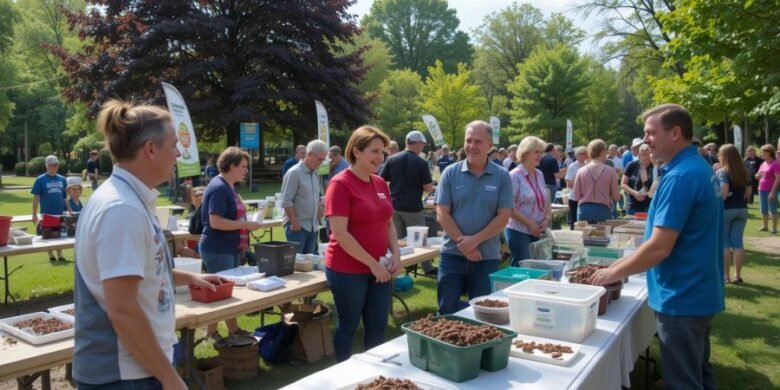A worm swap event is a creative and engaging way to bring your community together to share resources, knowledge, and enthusiasm for vermiculture. These events allow participants to trade worms, exchange vermicomposting supplies, and connect with fellow enthusiasts, all while promoting sustainable practices.
This guide will walk you through the steps to successfully organize a worm swap event in your community, from planning and promotion to execution and follow-up.
Benefits of a Worm Swap Event
1. Building Community Connections
- Brings together like-minded individuals passionate about sustainability.
- Encourages networking among local worm farmers, gardeners, and eco-conscious residents.
2. Sharing Resources
- Participants can trade worms, bedding materials, or vermicomposting supplies.
- Reduces costs by encouraging resource sharing and upcycling.
3. Promoting Sustainability
- Educates attendees about the benefits of vermiculture.
- Encourages participants to adopt eco-friendly practices like composting and waste reduction.
Step 1: Planning the Event
1. Define the Event’s Goals
Decide on the purpose of your worm swap event:
- Facilitating the exchange of worms and supplies.
- Educating participants about worm farming.
- Promoting community involvement in sustainability efforts.
2. Choose a Venue
Select a location that is accessible and suitable for the expected turnout:
- Community Centers: Offer ample space for tables and booths.
- Parks: Provide an outdoor setting ideal for nature-themed events.
- Local Gardens or Farms: Add a practical touch with hands-on demonstrations.
3. Set a Date and Time
- Choose a weekend or evening to maximize attendance.
- Allow at least 2-3 hours for participants to interact, exchange, and explore.
4. Organize the Activities
Plan activities to engage attendees:
- Swap Zone: Designate an area for trading worms and supplies.
- Workshops: Include short sessions on worm farming basics or advanced techniques.
- Q&A Sessions: Host an open forum for troubleshooting and expert advice.
Step 2: Promoting the Event
1. Use Social Media
- Create an event page on platforms like Facebook or Instagram.
- Share engaging posts leading up to the event, including tips on what to bring and what to expect.
2. Partner with Local Organizations
- Collaborate with gardening clubs, environmental groups, or schools to spread the word.
- Ask local businesses to sponsor or promote the event.
3. Distribute Flyers
- Design eye-catching flyers with event details.
- Post them in libraries, cafes, community boards, and garden stores.
4. Word of Mouth
Encourage participants to invite friends, family, and neighbors.
Step 3: Preparing for the Event
1. Set Up the Venue
- Arrange tables for worm and supply swaps.
- Create signage for different areas, such as the swap zone, workshops, and Q&A stations.
- Provide bins or containers for participants who need them.
2. Gather Supplies
- Worm bins, bedding materials, and food scraps for demonstrations.
- Handouts with tips and instructions for worm farming.
- Name tags for attendees to encourage networking.
3. Prepare an Agenda
Create a schedule that includes:
- Opening remarks to welcome attendees and explain the event.
- Times for workshops, swapping sessions, and Q&A discussions.
Step 4: Hosting the Event
1. Welcome Attendees
- Greet participants as they arrive and provide a brief overview of the event.
- Distribute name tags and any handouts.
2. Facilitate the Swap
- Ensure the swap area is well-organized and monitored.
- Encourage attendees to share tips about their supplies or worms during exchanges.
3. Run Workshops and Demos
- Keep sessions short and interactive to maintain interest.
- Include live demonstrations, such as setting up a worm bin or harvesting compost.
4. Encourage Networking
- Create opportunities for attendees to connect, such as discussion circles or breakout groups.
- Use icebreakers to get participants talking about their worm farming experiences.
Step 5: Following Up After the Event
1. Gather Feedback
- Distribute a survey to attendees to learn what they enjoyed and what could be improved.
- Use this feedback to refine future events.
2. Share Highlights
- Post photos and videos from the event on social media.
- Share success stories, such as unique trades or workshop highlights.
3. Keep the Community Engaged
- Start an online group or mailing list to keep participants connected.
- Plan follow-up events or workshops to sustain interest.
Tips for a Successful Worm Swap Event
- Make It Accessible: Choose a venue and time that accommodate a wide audience.
- Encourage Participation: Emphasize that all skill levels are welcome, from beginners to experts.
- Create a Welcoming Atmosphere: Foster an inclusive and friendly environment.
- Be Flexible: Adapt to the needs and interests of attendees as the event unfolds.
Conclusion
Organizing a worm swap event is a rewarding way to bring people together, promote sustainability, and encourage the spread of vermiculture. With careful planning and a focus on community engagement, your event can inspire participants to embrace worm farming while building lasting connections. Start planning your worm swap today and watch your community thrive through the power of collaboration and eco-friendly practices.




